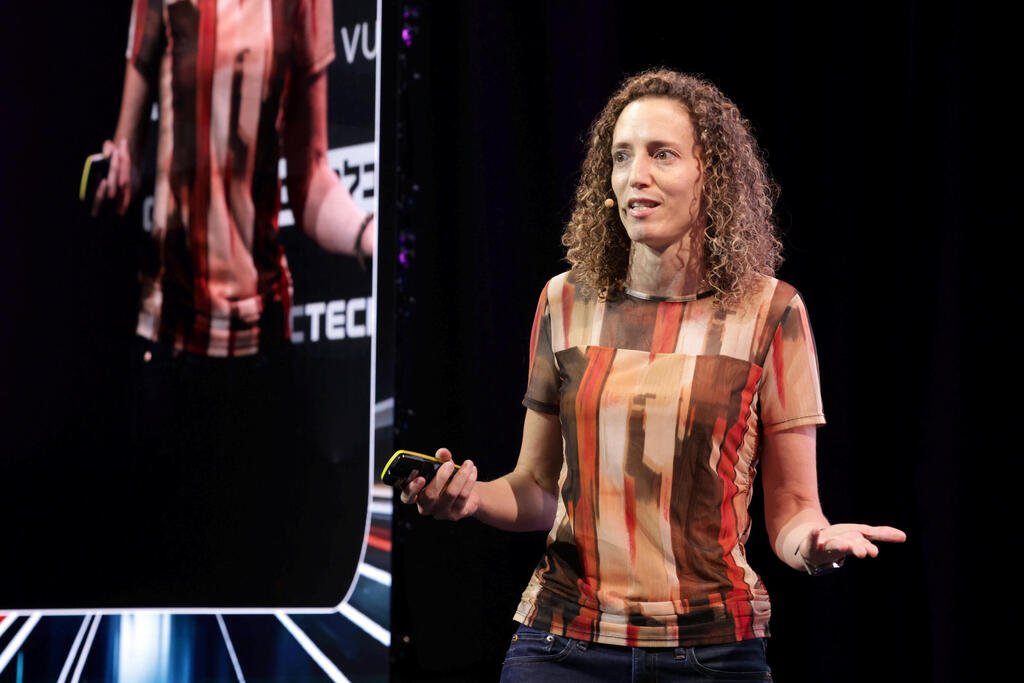
"Artificial intelligence is the Fourth Industrial Revolution"
Rotem Shacham, a director at PSG Equity, described the methodology she developed to identify the highest quality AI startups.
“Unlike other technological innovations of recent years, artificial intelligence is truly a revolution. In fact, it is the Fourth Industrial Revolution,” said Rotem Shacham, a director at PSG Equity, which invests in growing technology and software companies, speaking at Calcalist's AI conference.
“We have become accustomed to thinking that there was only one Industrial Revolution, but in fact, there have been several. The First Industrial Revolution, known as the Industrial Revolution, began nearly 300 years ago. Two defining events were the invention of the steam engine and the mechanical loom. The Second Industrial Revolution is usually attributed to the rise of electricity about a hundred years later. The Third Industrial Revolution was the digitization revolution, which began a little over 50 years ago with the invention of personal computers.”
Shacham says that today we are experiencing the Fourth Industrial Revolution. “This revolution revolves around the invention of artificial intelligence and encompasses technologies like computer vision, machine learning, natural language processing, and others,” she said. “What unites these revolutions is that technological innovation brought about a fundamental change in daily life through a significant leap in the productivity of both humans and machines. As we can see, revolutions are occurring more frequently, and their durations are shortening due to the increasing pace of innovation.”
The PSG director then shifted to discuss the many implications of the AI revolution which, she says, require new approaches to evaluating startups. “As an investor, I have the privilege of meeting many companies at various stages and trying to assess their quality and potential. That’s exactly why [PSG] developed our investment model, the AI Assessment Matrix.”
According to Shacham, much like during the dot-com bubble when adding ‘dot-com’ to a company's name was seen as a guarantee of success, today many companies seeking to raise capital claim to be AI companies but aren’t necessarily. “As investors, we must separate the wheat from the chaff, and for that, we need to develop methodologies like the one we've created.”
Shacham explained that her fund’s methodology maps companies across two axes; the first examines how much the extent to which the company’s core offering is based on AI technology. The greater the presence of AI is at the core of the product, the greater the power multiplier and value it will generate. The second axis examines how disruptive the company’s technology is, and whether the company or the market it operates in is undergoing disruption, or if the company company is disruptive (in a positive sense).
“Dividing the world along these axes creates four groups,” says Shacham. “The first group we call Trailblazers. These are companies built on an AI core and disrupting the market they operate in. These are pioneering companies that create new products or improve existing products or processes.”
The second group identified by Shacham are called Laggers. These are companies built on AI, but the pace of technological innovation in the last two years has left them behind, and they are being disrupted and delayed. The third group are known as Fast Adapters - companies that may not have been built with AI at their core, but have successfully adopted AI elements in a way that disrupts their competitors. The last group includes companies that weren’t built on AI, failed to adopt AI, and as a result, are in the Danger Zone and are being disrupted. They are designated as being at risk.
Shacham highlights two important elements in this matrix. “The first relates to the fact that we are at the beginning of the AI revolution. Therefore, there is an area we call the ‘Unaffected Zone’ - companies that currently aren’t affected by the AI revolution. That is, they are neither disrupting the market nor being disrupted themselves.”
According to Shacham, while there are some companies operating in this zone, “It’s important to understand that this is the current state, but one cannot rest on their laurels. As technology advances - and it is advancing rapidly - this area will shrink.”
The second element Shacham highlights relates to the position within the matrix, which she says is dynamic and “can change due to the company's actions, competitors, or overall market trends.” As an example, a company classified as a Lagger, who was once innovative but overtaken by others, can decide to significantly invest in R&D and become a Trailblazer.
What makes a Trailblazer?
Trailblazers are identified based on five specific characteristics: the first two relate to value, specifically how much value the product generates for end users, and the other three relate to how well the company can maintain its competitive edge over time. "The first criterion we look for is creating long-term value for the end customer. Here we ask questions like: Does the product create real value? Does it solve a genuine business problem, or is it just cool technology looking for a problem, as we unfortunately quite often see?," says Shacham.
"In other words, is it a vitamin or an antibiotic? If it's a vitamin, we'll find that the product isn't 'sticky,' and customers will stop using it as soon as signs of a recession appear. Additionally, we ask questions like: what is the extent of the value that the product generates? Is it leveraging AI to optimize a process or to replace a process entirely?"
The second criterion Shacham examines is efficacy & scalability. "We ask questions like: What is the goal or problem being addressed, and is AI the best approach? For example, does using AI reach the required levels of accuracy with the required number of attempts? Is a deterministic model required, which isn't necessarily suited for AI, or would a probabilistic model fit better?"
Shacham adds, "We also ask if the technology and product can grow efficiently. That is, do the revenue and cost models converge as the company scales? It's important to remember that developing AI-based products is an expensive journey that is sometimes not economically viable."
The third criterion is replaceability & flexibility: "Here, we examine the risk of the product or technology being replaced by a newer generation of technology," says Shacham. "At the same time, we assess how flexible the team is at adapting to changing market conditions. Flexibility and resilience are critical. Those who fail to evolve will quickly find themselves in the Danger Zone."
The fourth criterion is data uniqueness. "As foundational models in language and algorithms become more of a commodity, the data itself and its uniqueness become a competitive advantage. A model trained on general or insufficient data will yield inaccurate results," she says.
The fifth and final criterion is architecture or technological complexity of the product. "One AI model, or another, is usually not the whole story. Companies use models in certain parts of the product, so it's important to take a bird’s-eye view of the overall architecture," says Shacham.
"How complex is the architecture from an engineering perspective? How much of the value the product provides comes from the model layer, and how much from the application layer? Is the value concentrated in one model, or is it derived from the integration of various components, creating a whole greater than the sum of its parts?" According to Shacham, the more complex the architecture, the more that value is derived from different parts of the product, the stronger the company's competitive advantage.
"As investors, we want to see Trailblazer companies built on AI and disrupting the market they operate in," Shacham concluded. "Strong companies will respond positively to the five criteria we've outlined. Of course, not all companies meet these criteria, but these can also be used to identify companies with high potential."














